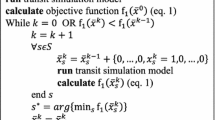Abstract
An analytical model for the determination of the number and locations of time points as well as the amount of slack times in transit schedule design is developed. The model considers a bus route with a special passenger demand pattern in which all boarding passengers coordinate their arrivals at each stop in such a way that they never miss their intended bus, and therefore designing the schedule separately a single run at a time, becomes possible. The model employs the dynamic programming method to deal with the trade-offs among various cost components associated with the schedule quantitatively, and yet is flexible enough to incorporate the existing rules of thumb as well as transit operators' policies. Numerical examples that illustrate the applications of the model are given. The model, although not quite applicable to bus routes with general passenger demand patterns, is useful in the analysis of the contributing factors to the design of an economical, reliable, and operational transit schedule, and is likely to be adaptable for more realistic cases.
Similar content being viewed by others
References
V.F. Hurdle, Minimum cost schedules for a public transportation route (I) theory, (II) examples, Transportation Science 7(1973)109.
S.C. Wirasinghe, Re-examination of Newell's dispatching policy and extensions to a public bus route with many to many time-varying demand, in:Proceedings of the 11th International Symposium on Transportation and Traffic Theory, Tokyo (1990).
C.W. Boyd, Notes on the theoretical dynamics of intermittent public passenger transportation systems, Transportation Research 17A(1983)347.
P.N. Seneviratne, Analysis of on-time performance of bus services using simulation, Journal of Transportation Engineering 116(1990)517.
J.G. Strathman and J.R. Hopper, Empirical analysis of bus transit on-time performance, Transportation Research 27A(1993)93.
L.J.S. Lesley, The role of the timetable in maintaining bus service reliability, in:Proceedings of the Symposium on Operating Public Transport, University of Newcastle-Upon-Tyne, UK (1975) p. 36.
M. Abkowitz and I. Engelstein, Methods for maintaining transit service regularity, Transportation Research Record 961(1984)1.
M. Abkowitz, E. Amir and I. Engelstein, Optimal control of headway variation on transit routes, Journal of Advanced Transportation 20(1986)73.
U. Vandebona and A. Richardson, Effect of checkpoint control strategies in a simulation transit operation, Transportation Research 20A(1986)429.
G.F. Newell, Unstable Brownian motion of a bus trip, in:Statistical Mechanics and Statistical Methods in Theory and Application (Plenum Press, New York, 1977).
S.C. Wirasinghe, Cost based approach to schedule travel time on a public transportation route, in:Proceedings of the 12th International Symposium on the Theory of Traffic Flow and Transportation, ed. C.F. Daganzo, Berkeley, CA (1993) p. 205.
Th.H.J. Muller, Trip time control in public transport: Simulation and experiments, in:Proceedings of the 20th International Scientific Conference on Transport Planning and Traffic Engineering, Budapest (1989).
A.M. Oliver and M.B. Uren, A computer simulation model of the E3 bus route: A detailed description, Technical Note TN42, Department of Operations Research, London Transport Executive (1972).
M.A. Turnquist and L.A. Bowman, The effects of network structure on reliability of transit service, Transportation Research 14B(1980)79.
P. Andersson and G. Scalia-Tomba, A mathematical model of an urban bus route, Transportation Research 15B(1981)249.
S.R. Pells, An approach to the simulation of bus passenger journey times for the journey to work, Transportation Planning and Technology 14(1989)19.
R.P. Guenthner and K. Hamat, Distribution of bus transit on-time performance, Transportation Research Record 1202(1988)1.
M.A. Turnquist, A model for investigating the effects of service frequency and reliability on bus passenger waiting times, Transportation Research Record 663(1978)70.
R.P. Guenthner and K.C. Sinha, Maintenance, schedule reliability, and transit system performance, Transportation Research 17A(1983)355.
S.M. Ross,Introduction to Probability Models (Academic Press, New York, 1973).
J.D. Hunt et al., Using variable demand auto assignment to implement mode split models in Edmonton and Calgary, in:Proceedings of the 8th Annual International EMME/2 Users Conference, Seattle (1993).
Author information
Authors and Affiliations
Rights and permissions
About this article
Cite this article
Wirasinghe, S.C., Liu, G. Determination of the number and locations of time points in transit schedule design — Case of a single run. Ann Oper Res 60, 161–191 (1995). https://doi.org/10.1007/BF02031945
Issue Date:
DOI: https://doi.org/10.1007/BF02031945




